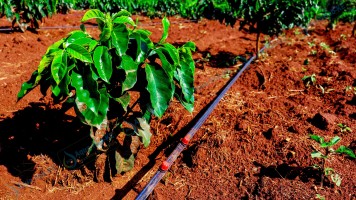Coffee Farming in Kenya: Practical best and Inexpensive Irrigation

Coffee farming in Kenya through irrigation is by using button dripper irrigation kits available at Aqua Hub Kenya. We offer quality button drippers on lower prices in Kenya.
Call 0790719020 for coffee farming irrigation kits and solar dryers.
Coffee is grown in high altitude areas in Kenya including Kiambu, Nyeri, Kirinyaga, Embu and other parts such as Meru and Machakos. These regions produce approximately 70% of Kenya’s total coffee yield which can be around 50,000 tons.
In this blog, you will learn how different varieties of coffee can be grown through irrigation to ensure quality and higher yield.
Common Varieties of Coffee Farming in Kenya
- Arabica – mild in the cup with less caffeine
- Robusta – clustered berries with large caffeine.
Coffee Research Foundation has produced 4 varieties of arabica coffee which are best for cultivation in different altitudes. They include.
- K7 – grown in areas with lower altitude. resistant to Coffee Leaf Rust (CLR).
- SL 28 – does well in medium altitude areas.
- SL 34 – high altitude areas with reliable rainfall.
- Ruiru 11 – suitable for all coffee suited areas. Resistant to coffee berry disease and leaf rust.
Conditions for Arabica Coffee Farming in Kenya
| Coffee Variety | Ideal Altitude | Quality | Yield | Disease Resistance |
| SL28 | 1500 – 1700 m | Exceptional | High | low |
| SL34 | At least 1500 m | Outstanding | High | low |
| K7 | 1200 – 1500 m | Good | High | Moderate |
| Ruiru 11 | 1000 – 1600 m | Good | High | High |
Climatic Conditions for Coffee Farming in Kenya
- Suitable temperature of 18°C to 24° C. temperature drop below 15 °C is not favorable
- Altitude of 1400 – 2000 m above the sea level.
- Rainfall exceeding1000 mm per annum.
- Soil PH of 4.4 to 5.4
- Well drained soil depth of at least 1.5 m
Ideal Coffee Irrigation Method In Kenya
Coffee can also be practically grown through irrigation especially in arid and semi-arid parts of Kitui, Machakos and Nanyuki. Irrigation systems can also be installed to optimize coffee yield for a year-round production.
The best way to water coffee plants is through button drippers. Button drippers offer a low-cost way to optimize irrigation coffee farming in Kenya. With sufficient flow rates, it provides balanced and controllable irrigation ensuring quality yield and lower infections.
Button Drippers for Coffee farming in Kenya
A button dripper is a small plastic lid that release steady flow of water to the plant roots. Button dripper irrigation involves connection of pipes, fittings and button emitters placed at equal intervals on the delivery pipe.
Cost of Button Drippers in Kenya
Button drippers for coffee farming in Kenya are KES 13 per piece.
We install button drip irrigation system at different prices depending on the size of the farm.
Steps for Starting Coffee Farming in Kenya
Land Preparation involves activities of clearing vegetation, removing rocks and cultivation to make the land ready for growing coffee.
Soil analysis and test: conduct soil PH tests by consulting an agronomist to ensure the area is free from infections.
Transplanting: seedlings are transplanting is between 8-10 months after propagation in bags. Reduce watering 1-2 months before transplanting to harden the seeds.
How to Prepare for Coffee transplanting
- First buy certified seeds from popular coffee farming research organizations in Kenya such as (KALRO).
- When purchasing seedlings, ensure you buy seedlings that are 30-40 cm tall with more than 2 branches to transplant.
- Water the soil or plant during onset of the rainy season when the moisture is 2ft deep.
- To avoid damaging the roots, remove the planting bags carefully and keeps its initial soil intact.
- Insert the plant into the planting hole and fill in soil and press the soil with hands without stepping on it.
Management Practices for Coffee Farming in Kenya
Applying mulches such as dry leaves on young coffee plants to prevent water stress.
Removing infected leaves and unwanted branches through pruning.
Growing short crops such as vegetables, beans, onions, garlic, and peas in between coffee rows. It should be done during the first 2 years of planting coffee before they grow taller.
How to Harvest Coffee
Once coffee beans turn bright red and firm, they are ready for harvesting.
Harvesting coffee takes place after every 2 weeks for over a period of 7-9 months. Handpick coffee berries selectively to ensure harvesting only ripe berries.
How to Dry Coffee Harvest
Drying coffee after processing is essential to maintain the quality and enhance value addition. Solar dryers are the most reliable structures that can be used to effectively dry coffee beans. We have proven and practically fast dryers which enhance cost reduction in coffee drying and storage.
To acquire a reliable solar dryer for coffee farming in Kenya, consult Aqua Hub Kenya who are the top-rated supplier.
